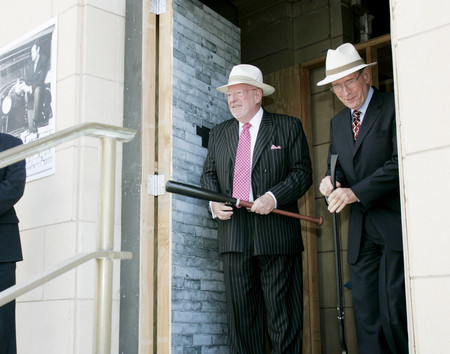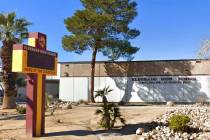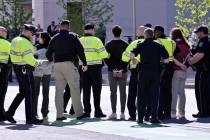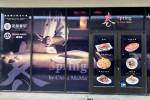Nostalgic, not noble: Mob Museum not meant to glorify organized crime, officials say
Tuesday's Mob Museum announcement could make your head spin from the contradictions.
There were elected officials and a former U.S. senator dressed as mobsters in suits and fedoras giving their blessing to a project they hope will energize downtown Las Vegas and give tourists a new reason to visit.
For props they had a crowbar and a baseball bat, implements for which the mob famously found creative uses. And with great excitement, one of the exhibits was announced: a wall where seven people were mercilessly gunned down.
Which just shows the tricky nature of the task of the Las Vegas Museum of Organized Crime and Law Enforcement: showcasing the role of mobsters in local history while trying not to glorify the organized crime.
Las Vegas Mayor Oscar Goodman and former U.S. Sen. Richard Bryan used a baseball bat and a crowbar -- both real -- to pretend to break through a fake brick wall Tuesday morning, signifying the start of museum renovations.
Goodman, a lawyer who in decades past represented figures who probably will be featured in exhibits, also announced the museum will be home to a very real, and really gruesome, brick wall section: a wall used as a backstop for the 1929 St. Valentine's Day Massacre in Chicago.
Interior renovations to the historic federal courthouse downtown, the museum's home-to-be, started this week, and the museum is expected to open in early 2011.
The museum aims to show the mob's role in Las Vegas' history as well as law enforcement's ultimately successful push against the gangsters.
"There's a history of the mob's involvement here, and this will record the history," said Bryan, a museum board member and former Nevada governor and U.S. senator. "It certainly was a part of the growth of the city. You can't deny that.
"It's important, I think, to emphasize that this is not to glorify the mob. They weren't fun guys at all."
Take the aforementioned St. Valentine's Day Massacre. On Feb. 14, 1929, four men dressed as police officers entered a warehouse used by members of a gang run by George "Bugs" Moran. They lined up six gang members and one hanger-on against a wall, produced machine guns and blazed away, according to the Chicago Historical Society.
The killings became a symbol for organized crime and gang violence and were attributed to rival Chicago gangster Al Capone. No one was ever tried for the slayings.
Mob money helped fuel development on the Strip from the 1940s to the 1970s, an era that defined Las Vegas to the world, said Goodman -- who, as a practicing attorney, represented organized crime figures after moving here in 1964.
"When I got here, the casinos were owned by individuals. At least, that's what they purported to be," he said. "It was discovered they were representing interests primarily from the Midwest with hidden ownership of the casinos."
Still, Goodman voiced some nostalgia for an era he recalls as being full of iconic entertainers, comped drinks and meals, and service with a smile.
"They knew your name. They treated you like a king. I hope that Las Vegas returns to that someday," he said. "I think that we've lost that as we've become more corporate. The mob was the one that set the bar."
But Goodman says he's not romanticizing the mob: "The bottom line is -- and nobody knows it better than I do -- law enforcement won. The mob is not here, and that's one of the reasons I became the mayor. I didn't have any clients left."
The museum carries an estimated $50 million price tag, broken down into $7 million in state and federal grants, $8 million in city funds and $35 million in redevelopment agency bonds.
A nonprofit group called 300 Stewart Avenue Corp. is working on the exhibit portion and will operate the museum. Some possible exhibits that have been mentioned are courtroom drawings from mob trials, memorabilia Goodman has in storage, and FBI evidence, such as old weapons, that the agency has retained.
The St. Valentine's Massacre warehouse was demolished in 1967. Canadian businessman George Patey purchased the wall and used it as an attraction in various venues, including a restaurant he ran. The bricks were later put into storage, and various reports have some of them being put up for sale.
Patey died in 2004 and it fell to his heirs to find a home for the bricks, whose cost to the city was not available.
Contact reporter Alan Choate at achoate@reviewjournal.com or 702-229-6435.
View the slide show





























